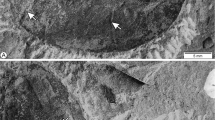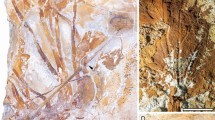Abstract
THE eucalypts are the outstanding group of Leptospermeae (subfamily Leptospermoideae of Myrtaceae) and of the whole Australian flora1. There are over 500 species of eucalypts, nearly all restricted to Australia. The origin of this remarkably diverse and successful genus has been a matter for speculation. The comparitively well known Tertiary palynological record is of little assistance in answering these questions, as spores and pollen have insufficient properties to identify the genus. Hence only the macrofloral record is taxonomically significant. Although Tertiary macrofossils4 are abundant, the fossil record of Eucalyptus and even Leptospermoideae is poorly known2,3. The first unequivocal fossil gumnuts (Eucalyptus fruits), of indefinite age, were identified only recently from silicified floras near Woomera5, in South Australia's present arid zone. These specimens were collected without reference to the stratigraphy. However, we have now collected specimens from similar silicified outcrops near Stuart Creek (Fig. 1), where their probable age may be deduced by correlation of the sediments with Tertiary sequences elsewhere in South Australia. Eucalyptus can now be placed in stratigraphic context.
This is a preview of subscription content, access via your institution
Access options
Subscribe to this journal
Receive 51 print issues and online access
$199.00 per year
only $3.90 per issue
Buy this article
- Purchase on Springer Link
- Instant access to full article PDF
Prices may be subject to local taxes which are calculated during checkout
Similar content being viewed by others
References
Penfold, A. R. & Willis, J. L. The Eucalypts (Interscience, New York, 1961).
Carr, D. J. & Carr, S. G. M. in The Evolution of Living Organisms (ed. Leeter, T. W.) 426–445 (Melbourne University Press, 1962).
Johnson, L. A. S. Proc. Linn. Soc. N.S.W. 97, 11–29 (1972).
Duigan, S. L. Proc. R. Soc. Vict. 63, 41–56 (1950).
Lange, R. T. Aust. J. Bot. 26, 221–233 (1978).
Ludbrook, N. H. Bull. geol. Surv. S. Aust. 40, 1–223 (1966).
Wopfner, H., Callen, R. A. & Harris, W. K. J. geol. Soc. Aust. 21, 17–52 (1974).
Barnes, L. C. & Pitt, G. M. Q. geol. Not. geol. Surv. S. Aust. 62, 2–8 (1977).
Stirton, R. A., Tedford, R. H. & Miller, A. H. Rec. S. Aust. Mus. 14, 19–61 (1961).
Callen, R. A. & Tedford, R. H. Trans. R. Soc. S. Aust. 100, 125–167 (1976).
Barnes, L. C. & Pitt, G. M. Q. geol. Not. geol. Surv. S. Aust. 59, 2–6 (1976).
Benbow, M. C. & Pitt, G. M. Q. geol. Not. geol. Surv. S. Aust. 68, 8–15 (1978).
Wopfner, H. in Silcretes in Australia (ed. Langford-Smith, T.) 93–141 (New England, Armidale, 1978).
Lange, R. T. Can. J. Bot. 56, 532–541 (1978).
Lange, R. T. N. Jb. Geol. Palaeont. Ahb. 151, 142–165 (1976).
Kemp, E. M. Palaeogeog. Palaeoclimat. Palaeoecol. 24, 169–208 (1978).
Kennett, J. P. Mar. Micropalaeont. 3, 301–345 (1978).
McGowran, B. Mar. Geol. 26, 1–39 (1978).
Savin, S. M. A. Rev. Earth planet. Sci. 5, 319–355 (1977).
Author information
Authors and Affiliations
Rights and permissions
About this article
Cite this article
AMBROSE, G., CALLEN, R., FLINT, R. et al. Eucalyptus fruits in stratigraphic context in Australia. Nature 280, 387–389 (1979). https://doi.org/10.1038/280387a0
Received:
Accepted:
Published:
Issue Date:
DOI: https://doi.org/10.1038/280387a0
Comments
By submitting a comment you agree to abide by our Terms and Community Guidelines. If you find something abusive or that does not comply with our terms or guidelines please flag it as inappropriate.



